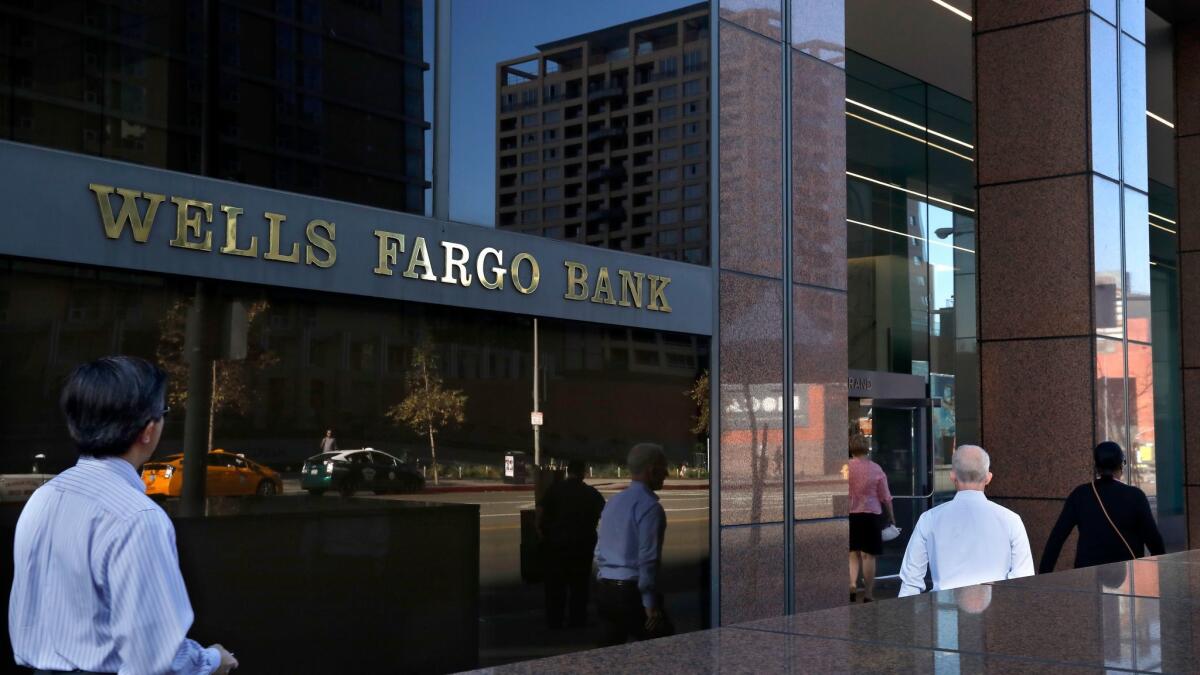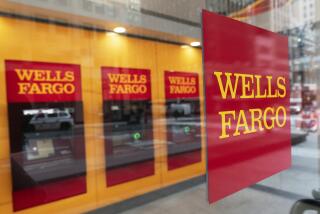Wells Fargo shares hammered by investors after unprecedented punishment by Federal Reserve

- Share via
On a day when the Dow experienced its biggest point loss in history, Wells Fargo & Co. did twice as bad.
The bank’s shares tumbled 9.2% on Monday — their biggest single-day drop since the financial crisis — reflecting just how much investors have lost faith in the San Francisco financial giant since it was severely punished last week for its accounts scandal and other assorted wrongdoing.
On Tuesday, Wells Fargo shares slipped an additional 0.8% to $57.65 around 8:45 a.m. Pacific Time.
The Federal Reserve on Friday ordered the bank to stop growing, an action that went far beyond the fines, legal settlements and other regulatory actions that have hit the bank over the last 18 months.
“This is a big deal. If it weren’t, the stock wouldn’t be down almost 10%,” said Scott Siefers, an analyst with Sandler O’Neill. “It’s a shocking penalty.”
The Fed also publicly chided the company’s board and two former chairmen — and Wells Fargo announced it would replace four board members this year.
Though Wells Fargo’s chief executive has said the bank will remain “open for business” and analysts say it will certainly continue to make loans and accept deposits, the Fed’s order will require the bank to cut back in some business areas and temporarily shelve growth plans.
Other banks have faced big penalties from the Fed, such as demands that they not make acquisitions or pay dividends, but it’s not clear how Wells Fargo’s penalty will affect the massive bank, the nation’s third-largest by assets.
“None of us have ever seen anything like this before,” Siefers said. “I’ve never seen an asset cap imposed on a company, at least publicly.”
Ken Leon, an equity analyst at research firm CFRA, likened Wells Fargo to an auto plant. With the economy expected to continue to grow over the next few years, the factory would ordinarily expect to ramp up production and churn out more vehicles.
Instead, regulators have ordered it to produce no more units than it did last year. So, as Wells Fargo works to stay in line with the Fed’s order, Leon said executives will be spending their time figuring out which of their loans are hot sellers and which are gathering dust on the lot.
“Management’s time will be shifting to trying to optimize performance without growing assets,” he said. “That means shifting their focus to looking for underperforming areas where they can reduce assets.”
A company presentation given to investors last week showed the bank has more than $180 billion tied up in various securities and short-term investments. Chief Executive Timothy Sloan said the bank could cut back on those holdings in order to free up assets to make loans.
Siefers said he expects mostly moves like that — ones in which the bank shifts assets out of hidden corners of its balance sheet and into loans and other more ordinary assets. He doesn’t expect the bank to cut back on the core business of making consumer and business loans.
“People hear about reducing assets or capping assets, and people think their home equity loan is going to be shuttered — but that’s not going to happen,” he said. “This is not going to affect Joe Smith’s loan. It’s going to be the more esoteric components of the bank’s balance sheet.”
However, Leon said he would not be surprised if the bank were to cut back on some parts of its core banking business. For instance, Wells Fargo — for years the nation’s largest mortgage lender — could cut back on its mortgage business as a way to free up assets.
There could be other effects, too, far beyond the type of loans the bank makes or the types of securities it holds.
In a Monday interview with Fox Business Network, Sloan said it’s possible the cap will be lifted by the end of this year. But until then, Siefers said, Wells Fargo’s competitors will be able to use the asset cap to woo away customers and bankers.
“Any competitor can go to a Wells Fargo customer and say, simplistically, ‘The Fed thinks Wells is in so much trouble that they can’t do X, Y and Z,’” he said. “I don’t actually think their ability to do commercial [loans] is impaired, but it’s an opportunity for competitors to come in and take market share.”
The same goes for bankers. Leon at CFRA said competitors might reach out to Wells Fargo bankers with a similar pitch: If a banker’s job is to offer loans — in other words, to produce assets — why work for a bank that is limited in the amount of assets it can produce?
Along with potentially affecting the bank’s day-to-day business, the Wells Fargo penalties are “a shot across the bow” of bank boardrooms, which in the past have avoided the fallout from scandals, said Ed Mills, a Washington policy analyst at brokerage Raymond James Financial Inc.
As part of its enforcement action, the Fed sent letters to former Wells Fargo Chairman Stephen Sanger and former Chairman and CEO John Stumpf, chiding them personally for failing to recognize or stop abusive practices. It also sent letters to current board members, saying the board had not lived up to the Fed’s oversight expectations.
“In the past, it’s been the CEO or C-suite executives or shareholders that have taken the pain and the boardroom has been largely shielded from regulatory action,” Mills said. “This is the Fed taking a big step into the boardroom and telling all directors that their actions are going to have consequences. I think you’re going to see a change in the makeup of some boards to make sure they have the expertise necessary to perform their oversight functions of these companies.”
The penalties could paradoxically pave the way for some loosening of regulations on smaller and regional banks by showing that regulators are willing to get tough on abuses, analysts said.
A bipartisan bill is pending in the Senate that would reduce the number of financial institutions that face heightened scrutiny required by the 2010 Dodd-Frank Wall Street Reform and Consumer Protection Act.
“Creating the perception that regulators are willing to take harsh actions against mega banks for misdeeds is critical in building and maintaining political support for bank deregulation,” Jaret Seiberg, an analyst with brokerage and investment bank Cowen & Co., wrote in a report Monday.
Mills said that reducing some regulations for smaller and regional banks would allow them to compete against Wells Fargo and the largest banks.
“The big banks are going to be the bogeyman that helps the Senate pass this bill,” Mills said.
The offset for loosening some regulations will be the willingness of regulators to levy harsh penalties on banks for violations, he said.
Friday’s Wells Fargo penalties were not the first time the Fed limited a large bank’s growth. In 2005, the Fed banned Citigroup Inc. from any significant mergers until it tightened risk controls in the wake of the bank’s involvement in the failures of Enron and WorldCom, as well as other problems. The ban was lifted a year later.
Although the Fed placed restrictions on dividends and stock buybacks for several banks in the aftermath of the financial crisis, regulators didn’t levy harsher penalties because of the instability of the financial system, Mills said.
With bank profits near record highs, there’s less drawback now to cracking down on bad actors, he said. And unlike some of the complex abuses in the financial crisis, Wells Fargo’s creation of unauthorized accounts was easy for average Americans and lawmakers to understand. That added to the pressure on the Fed to act, Mills said.
“That might be the lesson of this scandal: If you run afoul of regulators, don’t do it in a way that’s easily understood by average Americans,” Mills said.
The bank in 2016 admitted its workers created perhaps millions of unauthorized accounts, leading to a $185-million settlement with regulators and the Los Angeles city attorney’s office as well as a $142-million class-action settlement. The creation of sham accounts, first reported in a 2013 Times investigation, proved to be one of many abusive practices that were widespread at the bank, including forcing unnecessary car insurance on auto-loan customers.
The wrongdoing prompted the bank to replace its CEO and several board members, eliminate account sales goals blamed for encouraging sham accounts and take other steps to right itself. However, Friday’s action by the Fed implied the regulator was not satisfied.
The latest action against Wells Fargo came amid a change of leadership at the Fed, which plays an important role in oversight of the largest banks in the country.
The Wells Fargo penalties were the last official act of Fed Chairwoman Janet L. Yellen, a Democrat who has been outspoken on the need for tough regulations and oversight in the wake of the 2008 financial crisis. Her successor, Jerome H. Powell, a Republican tapped by President Trump who was formally sworn in on Monday, has served on the Fed board since 2012. He has largely supported the cental brank’s tougher stance, though he has indicated he’s open to easing regulations for smaller and regional banks.
Powell, who was the Fed policymaker overseeing the Wells Fargo negotiations, voted for the penalties along with Yellen and Fed Gov. Lael Brainard. The Fed’s other board member, Randal Quarles, a Trump pick who began his term in October, recused himself from any matters involving Wells Fargo to avoid the appearance of conflict of interest because members of his extended family had sold their interest in a bank to Wells Fargo.
Powell’s views on financial regulation will become clearer in the coming weeks, Mills said. But in an August speech, Powell indicated the Fed would continue to hold corporate boards to higher levels of accountability.
“Across a range of responsibilities, we simply expect much more of boards of directors than ever before,” he told a Fed conference for directors of large banks. “There is no reason to expect that to change.”
Twitter: @jrkoren
Twitter: @JimPuzzanghera
More to Read
Inside the business of entertainment
The Wide Shot brings you news, analysis and insights on everything from streaming wars to production — and what it all means for the future.
You may occasionally receive promotional content from the Los Angeles Times.











